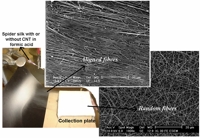
1Fibrous Materials Laboratory, Department of Materials Science and Engineering, Drexel University, 31st and Market street, Philadelphia, PA 19104, U.S.A.
2School of Biomedical Engineering, Sciences and Health System, Drexel University, Philadelphia, PA 19104, U.S.A., and
3Nexia Biotechnologies, 1000 St-Charles Avenue, Block B, Vaudreuil-Dorion, Quebec J7V 8P5, Canada
e-mail: fko@coe.drexel.edu
